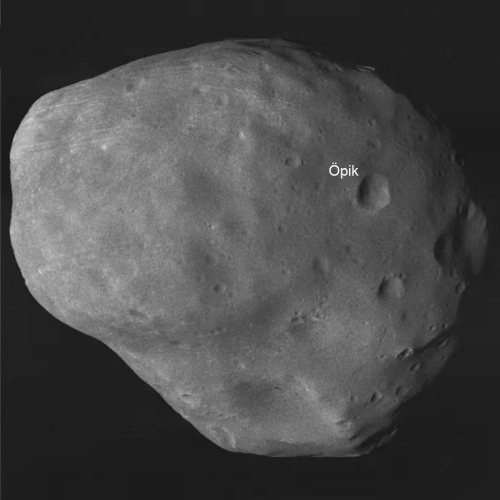China releases one photo of Phobos taken by its Tianwen-1 Mars orbiter
China today released a single photo of the Martian moon Phobos, taken by its Tianwen-1 Mars orbiter, to mark the second anniversary of the orbiter’s launch.
The English press release at the link conveniently did not provide the image to the non=Chinese world, but the Chinese language release did. That picture is to the right, reduced slightly to post here. Considering its disinterest in making it easy to find this photo for English speakers, it is intriguing that China included the English language name Opik for one crater.
Moreover, this single picture release illustrates the paucity of Tianwen-1 photos made available to the public by China. Very few have been released, and though eventually China has been making its raw data available, it has not been doing so in a manner that makes it easy for outsiders to access it.
Nonetheless, this is one of the best pictures of Phobos I have yet seen.
On Christmas Eve 1968 three Americans became the first humans to visit another world. What they did to celebrate was unexpected and profound, and will be remembered throughout all human history. Genesis: the Story of Apollo 8, Robert Zimmerman's classic history of humanity's first journey to another world, tells that story, and it is now available as both an ebook and an audiobook, both with a foreword by Valerie Anders and a new introduction by Robert Zimmerman.
The print edition can be purchased at Amazon or from any other book seller. If you want an autographed copy the price is $60 for the hardback and $45 for the paperback, plus $8 shipping for each. Go here for purchasing details. The ebook is available everywhere for $5.99 (before discount) at amazon, or direct from my ebook publisher, ebookit. If you buy it from ebookit you don't support the big tech companies and the author gets a bigger cut much sooner.
The audiobook is also available at all these vendors, and is also free with a 30-day trial membership to Audible.
"Not simply about one mission, [Genesis] is also the history of America's quest for the moon... Zimmerman has done a masterful job of tying disparate events together into a solid account of one of America's greatest human triumphs."--San Antonio Express-News
China today released a single photo of the Martian moon Phobos, taken by its Tianwen-1 Mars orbiter, to mark the second anniversary of the orbiter’s launch.
The English press release at the link conveniently did not provide the image to the non=Chinese world, but the Chinese language release did. That picture is to the right, reduced slightly to post here. Considering its disinterest in making it easy to find this photo for English speakers, it is intriguing that China included the English language name Opik for one crater.
Moreover, this single picture release illustrates the paucity of Tianwen-1 photos made available to the public by China. Very few have been released, and though eventually China has been making its raw data available, it has not been doing so in a manner that makes it easy for outsiders to access it.
Nonetheless, this is one of the best pictures of Phobos I have yet seen.
On Christmas Eve 1968 three Americans became the first humans to visit another world. What they did to celebrate was unexpected and profound, and will be remembered throughout all human history. Genesis: the Story of Apollo 8, Robert Zimmerman's classic history of humanity's first journey to another world, tells that story, and it is now available as both an ebook and an audiobook, both with a foreword by Valerie Anders and a new introduction by Robert Zimmerman.
The print edition can be purchased at Amazon or from any other book seller. If you want an autographed copy the price is $60 for the hardback and $45 for the paperback, plus $8 shipping for each. Go here for purchasing details. The ebook is available everywhere for $5.99 (before discount) at amazon, or direct from my ebook publisher, ebookit. If you buy it from ebookit you don't support the big tech companies and the author gets a bigger cut much sooner.
The audiobook is also available at all these vendors, and is also free with a 30-day trial membership to Audible.
"Not simply about one mission, [Genesis] is also the history of America's quest for the moon... Zimmerman has done a masterful job of tying disparate events together into a solid account of one of America's greatest human triumphs."--San Antonio Express-News



“The Tianwen-1 operation team seized the timing when the orbiter was close to Phobos and obtained clear images of the satellite in its “full moon” state…”
That is not a “full moon” state. Such expressions as full-moon, half-moon, etc. are only relative to the position of the observer, since obviously half the moon is illuminated at any given time. The position of the spacecraft is very far from the position where Phobos would appear from it to be a full-moon
“That is not a “full moon” state. Such expressions as full-moon, half-moon, etc. are only relative to the position of the observer,”
The observer being the spacecraft taking the photo, the side of Phobos in the photo looks illuminated from limb to limb to me.
Robert, you buried the lede.
@ Ray Van Dune, a have to agree with Andrew_W here…. By your logic, when we see a “full moon” once a month here on earth, we are not seeing a full moon?
Anyway, pedantry aside… I had forgotten about those mysterious lines all over this little moon… I kinda remember some nonsense theory about captured astroids rolling across the surface… Does anyone have a link to any updated theory?
I agree with Mr Z, this is one of the better pics of Phobos I’ve seen.